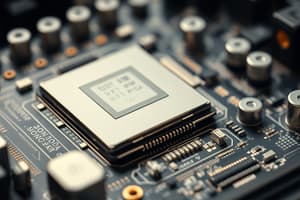Podcast
Questions and Answers
Which of the following best describes the purpose of the Control Unit within a CPU?
Which of the following best describes the purpose of the Control Unit within a CPU?
- It performs arithmetic and logical operations.
- It fetches data from memory and decodes instructions. (correct)
- It manages data transfers based on user inputs.
- It stores intermediate results of computations.
What is a primary characteristic of a Complex Instruction Set Computer (CISC)?
What is a primary characteristic of a Complex Instruction Set Computer (CISC)?
- It uses a set of simple, uniform instructions.
- It can execute instructions of varying lengths. (correct)
- All operands must be located in processor registers.
- It is designed exclusively for embedded systems.
In the context of instruction execution, which action occurs immediately after an instruction is fetched?
In the context of instruction execution, which action occurs immediately after an instruction is fetched?
- Store
- Decode (correct)
- Execute
- Power on
What does the acronym RISC stand for and what is its main advantage?
What does the acronym RISC stand for and what is its main advantage?
Which statement accurately describes volatile memory?
Which statement accurately describes volatile memory?
What is the correct definition of access time in computer memory?
What is the correct definition of access time in computer memory?
Which of the following storage capacities is equivalent to 1,073,741,824 bytes?
Which of the following storage capacities is equivalent to 1,073,741,824 bytes?
Which retrieval method entails the sequential access of data?
Which retrieval method entails the sequential access of data?
What is the primary function of transfer rate in computer memory?
What is the primary function of transfer rate in computer memory?
Which of the following correctly states the number of bytes in a terabyte?
Which of the following correctly states the number of bytes in a terabyte?
Flashcards
Computer Hardware
Computer Hardware
The physical components of a computer system, such as the CPU, RAM, and hard drive
Computer Processor (CPU)
Computer Processor (CPU)
The brain of the computer, responsible for executing instructions
RISC Processor
RISC Processor
Processor design using simple instructions with operands in registers.
Computer Memory (Storage)
Computer Memory (Storage)
Signup and view all the flashcards
Instruction Execution Cycle
Instruction Execution Cycle
Signup and view all the flashcards
ROM Retrieval Methods
ROM Retrieval Methods
Signup and view all the flashcards
Storage Capacity
Storage Capacity
Signup and view all the flashcards
Kilobyte (KB)
Kilobyte (KB)
Signup and view all the flashcards
Access Time
Access Time
Signup and view all the flashcards
Transfer Rate
Transfer Rate
Signup and view all the flashcards
Study Notes
Computer Hardware
- Computer systems consist of hardware, software, and the human user
- Hardware are the physical components
- Software are the instructions that tell the hardware what to do
- The human user operates the system
Computer Processor (CPU)
- The CPU is made up of electronic components that process data
- The components include an arithmetic logic unit (ALU) and a control unit
- It has registers that hold data and instructions temporarily
- The instruction execution cycle includes fetch, decode, execute, and store steps
- The process continuously repeats until the computer is turned off
Processor Design Types
- Reduced Instruction Set Computer (RISC): Uses simple instructions. Operands are usually held in processor registers, and not in memory, which simplifies design. Ex: fixed instruction size
- Complex Instruction Set Computer (CISC): Uses complex instructions. Operands can be in registers or memory. Instruction size varies and often uses a microprogram.
Computer Memory (Storage)
- Computer memory stores instructions and data waiting to be used by the processor
- Memory includes various types and storage media (e.g. OS software, Application programs, Data, Volatile (RAM), Non-volatile (ROM)).
- Cache: Temporary storage, very fast, but expensive. Small size, small capacity.
- RAM (Random Access Memory): Temporary storage, fast, affordable. Medium size, medium capacity.
- ROM (Read-Only Memory): Permanent Storage, slow, cheap, Large size, large capacity.
- Storage Device types: ROM/BIOS, HDD, Removable.
- Retrieval Methods: Sequential or Direct
Computer Memory (Capacity)
- Capacity: The amount of data that a storage medium holds. Measured in bytes, kilobytes, megabytes, gigabytes (and larger units such as terabytes, etc)
- Access time: Time taken to retrieve an item.
- Transfer rate: Speed at which data moves to/from a device.
Computer Software
- Software controls and manages computer devices and processes.
- System Software: Concerned with the computer itself. Examples include operating systems (OS).
- Operating System (OS):
- Starts the system
- Communicates between hardware and software
- Controls timing of events
- Manages data for security and integrity
- Manages programs, memory and system performance
- Manages files, schedules tasks and configures devices
- Controls networks, security and provides a user interface (UI)
- Examples: Windows, Mac OS, Unix
Studying That Suits You
Use AI to generate personalized quizzes and flashcards to suit your learning preferences.




